Numerical Study on Tsunami Force on Coastal Bridge Decks with Superelevation
Abstract
1. Introduction
2. Materials and Methods
2.1. Simulation Methodology
2.2. Numerical Model
2.3. Validation
2.4. Numerical Test Plan
3. Results and Discussion
3.1. Time Histories of the Wave Forces
3.2. Characteristic Tsunami Forces for a Box Girder Bridge Deck without Superelevation
3.3. Characteristic Tsunami Forces for a Box Girder Bridge Deck with Superelevation
4. Conclusions
Author Contributions
Funding
Data Availability Statement
Conflicts of Interest
Notation List
| h0 | Downstream still water depth (m) |
| h1 | Upstream reservoir water depth (m) |
| h2 | Wave height (m) |
| Zd | Distance from the flume bed to the bottom of the deck (m) |
| θ | Girder superelevation (°) |
| h | Girder height (m) |
| u | Bore velocity (m/s) |
| Fx, Fy | Measured horizontal and vertical forces (N) |
| R | Relative clearance height |
| Q | Relative reservoir height |
| Fx,max, Fy,max | Maximum value of the measured horizontal and vertical forces (N) |
| Av | Vertical projected area of the bridge deck (m2) |
| Ah | Horizontal projected area of the bridge deck (m2) |
| Fx,ave, Fy,ave | Average horizontal and average tsunami forces during the flow-around stage (N) |
| F0x,ave, F0y,ave | Average horizontal and average tsunami forces during the flow-around stage at θ = 0° (N) |
References
- Kazama, M.; Noda, T. Damage statistics (Summary of the 2011 off the Pacific Coast of Tohoku Earthquake damage). Soils Found. 2012, 52, 780–792. [Google Scholar] [CrossRef]
- Maruyama, K.; Tanaka, Y.; Hosoda, A. Damage of bridge structures by huge tsunami and evaluation of tsunami force on bridges. In Proceedings of the 8th International Symposium on Social Management Systems, New York, NY, USA, 1 May 2012. [Google Scholar]
- Hayatdavoodi, M.; Seiffert, B.; Ertekin, R.C. Experiments and computations of solitary-wave forces on a coastal-bridge deck. Part II: Deck with girders. Coast. Eng. 2014, 88, 210–228. [Google Scholar] [CrossRef]
- Huang, B.; Zhu, B.; Cui, S.; Duan, L.; Zhang, J. Experimental and numerical modelling of wave forces on coastal bridge superstructures with box girders, Part I: Regular waves. Ocean Eng. 2018, 149, 53–77. [Google Scholar] [CrossRef]
- Istrati, D.; Buckle, I. Role of Trapped Air on the Tsunami-Induced Transient Loads and Response of Coastal Bridges. Geosciences 2019, 9, 191. [Google Scholar] [CrossRef]
- Xu, G.; Cai, C.S.; Chen, Q. Countermeasure of Air Venting Holes in the Bridge Deck–Wave Interaction under Solitary Waves. J. Perform. Constr. Facil 2017, 31, 04016071. [Google Scholar] [CrossRef]
- Xu, G.; Cai, C.S.; Han, Y. Investigating the Characteristics of the Solitary Wave-Induced Forces on Coastal Twin Bridge Decks. J. Perform. Constr. Facil 2016, 30, 04015076. [Google Scholar] [CrossRef]
- Zhao, E.; Sun, J.; Tang, Y.; Mu, L.; Jiang, H. Numerical investigation of tsunami wave impacts on different coastal bridge decks using immersed boundary method. Ocean Eng. 2020, 201, 107132. [Google Scholar] [CrossRef]
- Qu, K.; Tang, H.S.; Agrawal, A.; Cai, Y.; Jiang, C.B. Numerical investigation of hydrodynamic load on bridge deck under joint action of solitary wave and current. Appl. Ocean Res. 2018, 75, 100–116. [Google Scholar] [CrossRef]
- Chen, C.; Melville, B.W.; Nandasena, N.A.K.; Farvizi, F. An Experimental Investigation of Tsunami Bore Impacts on a Coastal Bridge Model with Different Contraction Ratios. J. Coast. Res. 2018, 342, 460–469. [Google Scholar] [CrossRef]
- Farvizi, F.; Melville, B.W.; Shamseldin, A.Y.; Shafiei, S. Experimental investigation of the effects of contraction on tsunami-induced forces and pressures on a box section bridge. J. Hydro-Environ. Res. 2022, 40, 116–130. [Google Scholar] [CrossRef]
- Farvizi, F.; Melville, B.W.; Shamseldin, A.Y.; Shafiei, S.; Hendi, E. Experimental investigation of tsunami bore-induced forces and pressures on skewed box section bridges. Ocean Eng. 2021, 224, 108730. [Google Scholar] [CrossRef]
- Nakao, H.; Nozaka, K.; Izuno, K.; Kobayashi, H. Tsunami hydrodynamic force on various bridge sections. In Proceedings of the 15th World Conference on Earthquake Engineering, Lisbon, Portugal, 24–28 September 2012. [Google Scholar]
- Xu, Z.; Melville, B.; Nandasena, N.A.K.; Whittaker, C.; Shamseldin, A.; Farvizi, F. Tsunami loads on slab bridges. Coast. Eng. 2021, 165, 103853. [Google Scholar] [CrossRef]
- Yang, W.; Liu, Y.; Yang, Y.; Liu, D.; Ning, J.; Zhang, Y.; Yang, H. Study on air escape in submerging process of multi-box girder attacked by flood. Ocean Eng. 2023, 273, 113891. [Google Scholar] [CrossRef]
- Istrati, D.; Buckle, I.G. Effect of fluid-structure interaction on connection forces in bridges due to tsunami loads. In Proceedings of the 30th US-Japan Bridge Engineering Workshop, Washington, DC, USA, 21–23 October 2014. [Google Scholar]
- Leschka, S.; Oumeraci, H. Solitary waves and bores passing three cylinders-effect of distance and arrangement. In Proceedings of the 34th Conference on Coastal Engineering, Seoul, Republic of Korea, 15–20 June 2014. [Google Scholar]
- Chanson, H. Tsunami surges on dry coastal plains: Application of dam break wave equations. Coast. Eng. J. 2006, 48, 355–370. [Google Scholar] [CrossRef]
- Yang, Z.; Huang, B.; Zhu, B.; Zhang, J.; Kang, A. Comparative Study of Tsunami-Like Wave-Induced Forces on Medium-Scale Models of Box Girder and T-Girder Bridges. J. Bridge Eng. 2021, 26, 04020125. [Google Scholar] [CrossRef]
- Wong, H.K. Three-Dimensional Effects of Tsunami Impact on Bridges. Ph.D. Thesis, University of Washington, Washington, DC, USA, 2015. [Google Scholar]
- Fang, Q.; Liu, J.; Hong, R.; Guo, A.; Li, H. Experimental investigation of focused wave action on coastal bridges with box girder. Coast. Eng. 2021, 165, 103857. [Google Scholar] [CrossRef]
- Guo, A.; Fang, Q.; Bai, X.; Li, H. Hydrodynamic Experiment of the Wave Force Acting on the Superstructures of Coastal Bridges. J. Bridge Eng. 2015, 20, 04015012. [Google Scholar] [CrossRef]
- Winter, A.O.; Motley, M.R.; Eberhard, M.O. Tsunami-Like Wave Loading of Individual Bridge Components. J. Bridge Eng. 2018, 23, 04017137. [Google Scholar] [CrossRef]
- Yang, W.; Lai, W.; Zhu, Q.; Zhang, C.; Li, F. Study on generation mechanism of vertical force peak values on T-girder attacked by tsunami bore. Ocean Eng. 2020, 196, 106782. [Google Scholar] [CrossRef]
- Nakamura, T.; Sawa, Y.; Mizutani, N. Experimental Study on Characteristics Of Tsunami-Induced Pressure And Force Acting on a Bridge Superstructure. J. Jpn. Soc. Civ. Eng. Ser. B3 (Ocean. Eng.) 2014, 70, I_420–I_425. [Google Scholar] [CrossRef]
- Nakamura, T.; Sawa, Y.; Mizutani, N. Study on the Evaluation of Temporal Change in Horizontal and Vertical Tsunami Forces Acting on a Bridge Superstructure. Coast. Eng. J. 2018, 58, 1640020. [Google Scholar] [CrossRef]
- Lukkunaprasit, P.; Lau, T.L. Influence of bridge deck on tsunami loading on inland bridge piers. IES J. Part A Civ. Struct. Eng. 2011, 4, 115–121. [Google Scholar] [CrossRef]
- Issakhov, A.; Borsikbayeva, A. The impact of a multilevel protection column on the propagation of a water wave and pressure distribution during a dam break: Numerical simulation. J. Hydrol. 2021, 598, 126212. [Google Scholar] [CrossRef]
- Bullock, G.; Crawford, A.; Hewson, P.; Walkden, M.; Bird, P. The influence of air and scale on wave impact pressures. Coast. Eng. 2001, 42, 291–312. [Google Scholar] [CrossRef]
- Motley, M.R.; Wong, H.K.; Qin, X.; Winter, A.O.; Eberhard, M.O. Tsunami-Induced Forces on Skewed Bridges. J. Waterw. Port Coast. Ocean. Eng. 2016, 142, 04015025. [Google Scholar] [CrossRef]
- Seiffert, B.R.; Ertekin, R.C.; Robertson, I.N. Wave loads on a coastal bridge deck and the role of entrapped air. Appl. Ocean Res. 2015, 53, 91–106. [Google Scholar] [CrossRef]
- Wei, Z.; Dalrymple, R.A. Numerical study on mitigating tsunami force on bridges by an SPH model. J. Ocean. Eng. Mar. Energy 2016, 2, 365–380. [Google Scholar] [CrossRef]
- Nassiraei, H.; Heidarzadeh, M.; Shafieefar, M. Numerical Simulation of Long Waves (Tsunami) Forces on Caisson Breakwaters. Sharif J. Civ. Eng. 2016, 32, 3–12. [Google Scholar]
- Gao, H.; Song, Y.; Fang, Q.; Li, S. Wave forces on box-girder-type bridge deck located behind trench or breakwater. Ocean Eng. 2021, 237, 109618. [Google Scholar] [CrossRef]
- Zhang, G.; Hoshikuma, J.-i. An Experimental Study on Countermeasure for Mitigating Tsunami Effect on Highway Bridge. In Proceedings of the 15th World Conference on Earthquake Engineering, Lisbon, Portugal, 24–28 September 2012. [Google Scholar]
- Abukawa, T.; Nakamura, Y.; Hasegawa, A. Effect of reducing tsunami damage by installing fairing in Kesen-Bridge. Earthq. Struct. 2014, 7, 1045–1060. [Google Scholar] [CrossRef]
- Nakamura, T.; Mizutani, N.; Ren, X. Study on Countermeasures for Reducing Tsunami Force Acting on a Bridge Superstructure And Its Effect on the Motion Of the Superstructure. J. Jpn. Soc. Civ. Eng. Ser. B3 (Ocean. Eng.) 2013, 69, I_359–I_364. [Google Scholar] [CrossRef]
- Bricker, J.D.; Nakayama, A. Contribution of Trapped Air, Deck Superelevation, and Nearby Structures to Bridge Deck Failure during a Tsunami. J. Hydraul. Eng. 2014, 140, 05014002. [Google Scholar] [CrossRef]
- Shigematsu, T.; Liu, P.L.F.; Oda, K. Numerical modeling of the initial stages of dam-break waves. J. Hydraul. Res. 2004, 42, 183–195. [Google Scholar] [CrossRef]
- Launder, B.E.; Sharma, B.I. Application of the energy-dissipation model of turbulence to the calculation of flow near a spinning disc. Lett. Heat Mass Transfer 1974, 1, 131–137. [Google Scholar] [CrossRef]
- Stoker, J. Water Waves. The Mathematical Theory with Applications; Wiley-Interscience: New York, NY, USA, 1957. [Google Scholar]
- Nakao, H.; Zhang, G.; Sumimura, T.; Hoshikuma, J. Effect of cross-sectional configuration of superstructure on hydrodynamic behavior of bridges subjected to tsunami-induced loading. J. Jpn. Soc. Civ. Eng. Ser. A1 (Struct. Eng. Earthq. Eng.) 2013, 69, I.42–I.54. [Google Scholar]

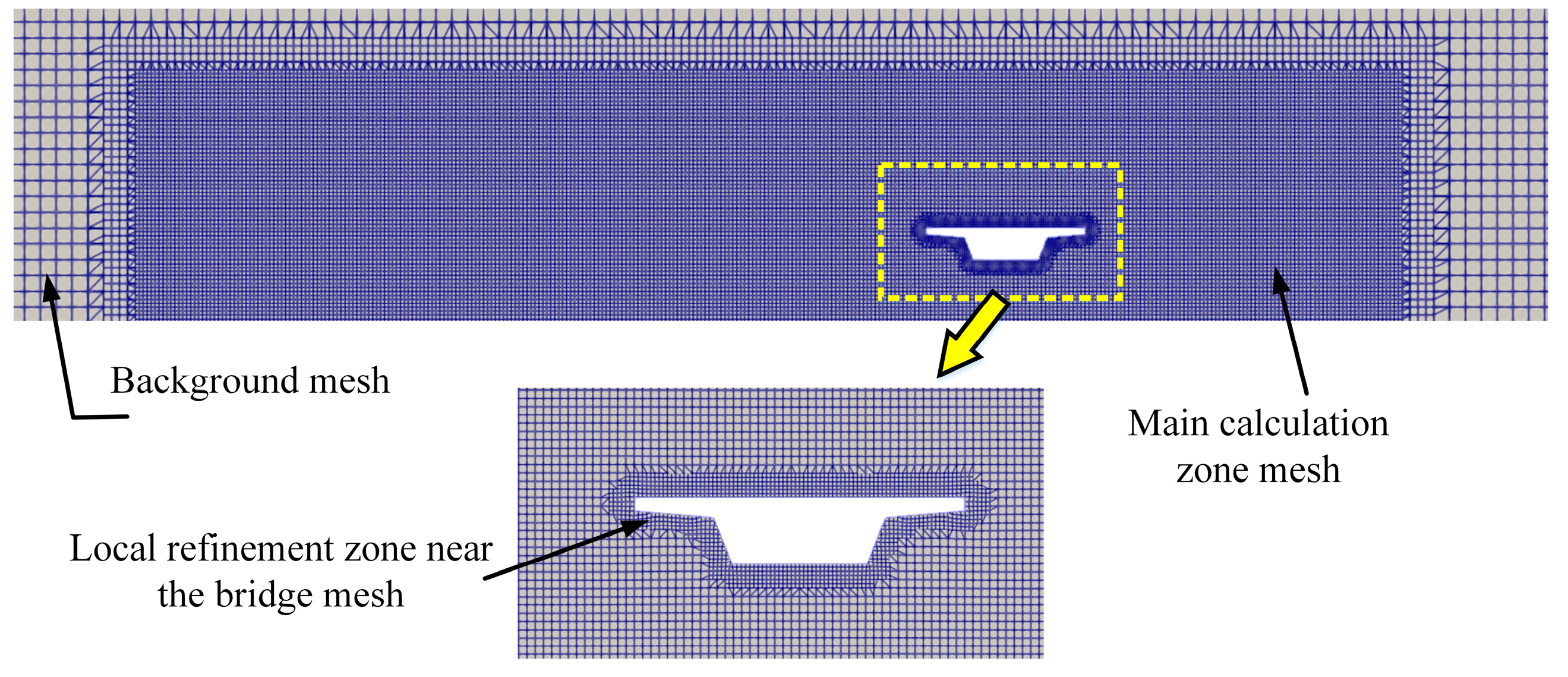
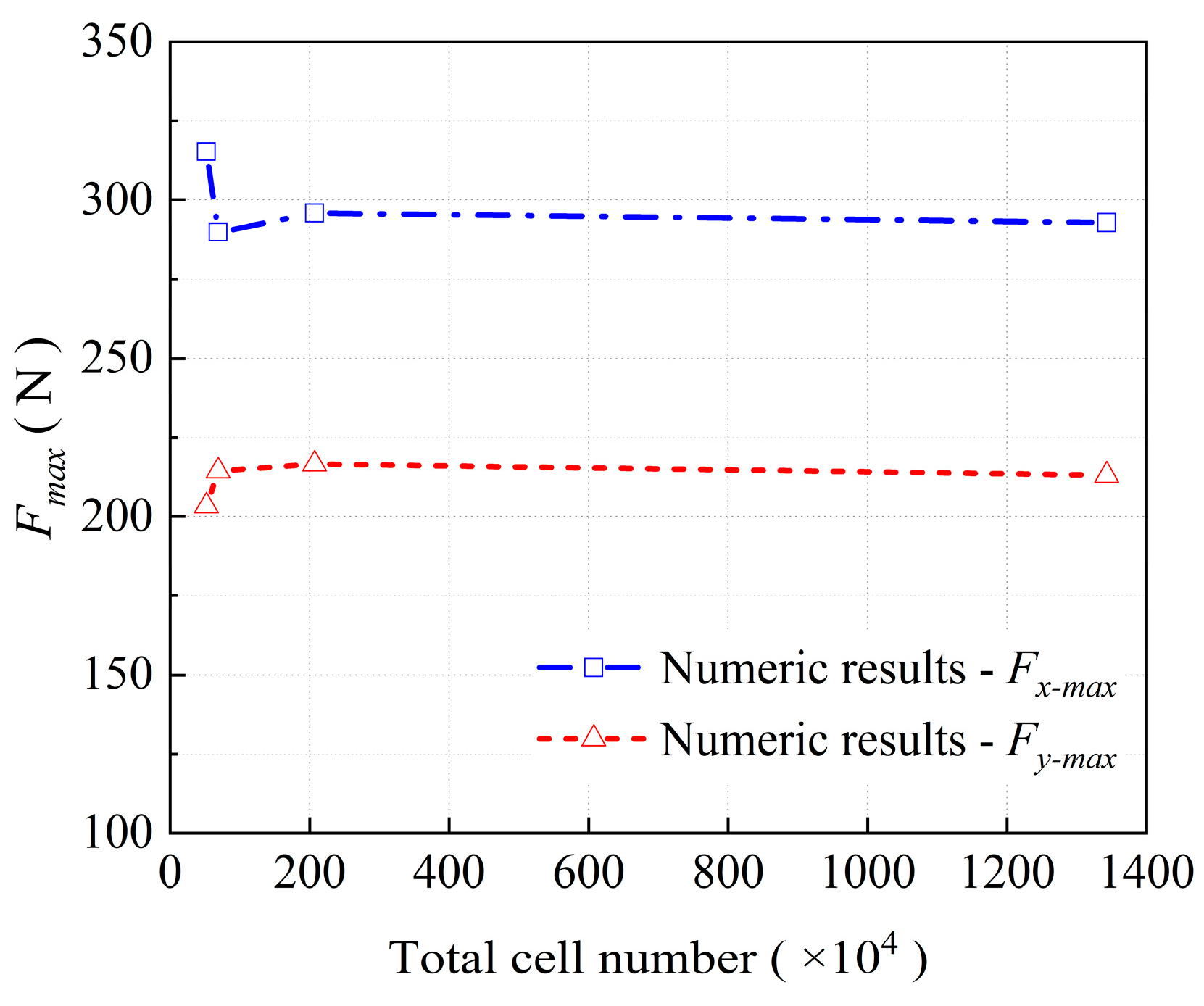
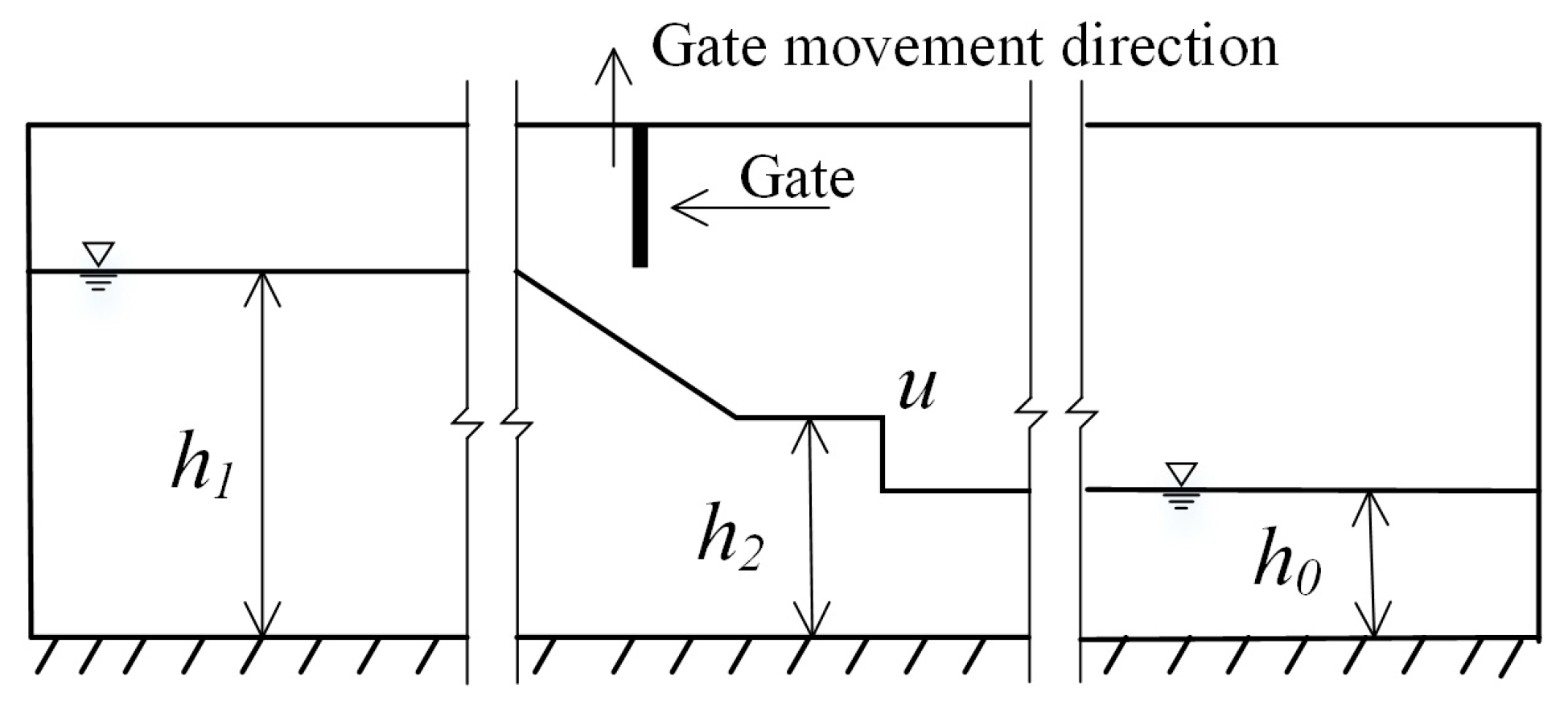
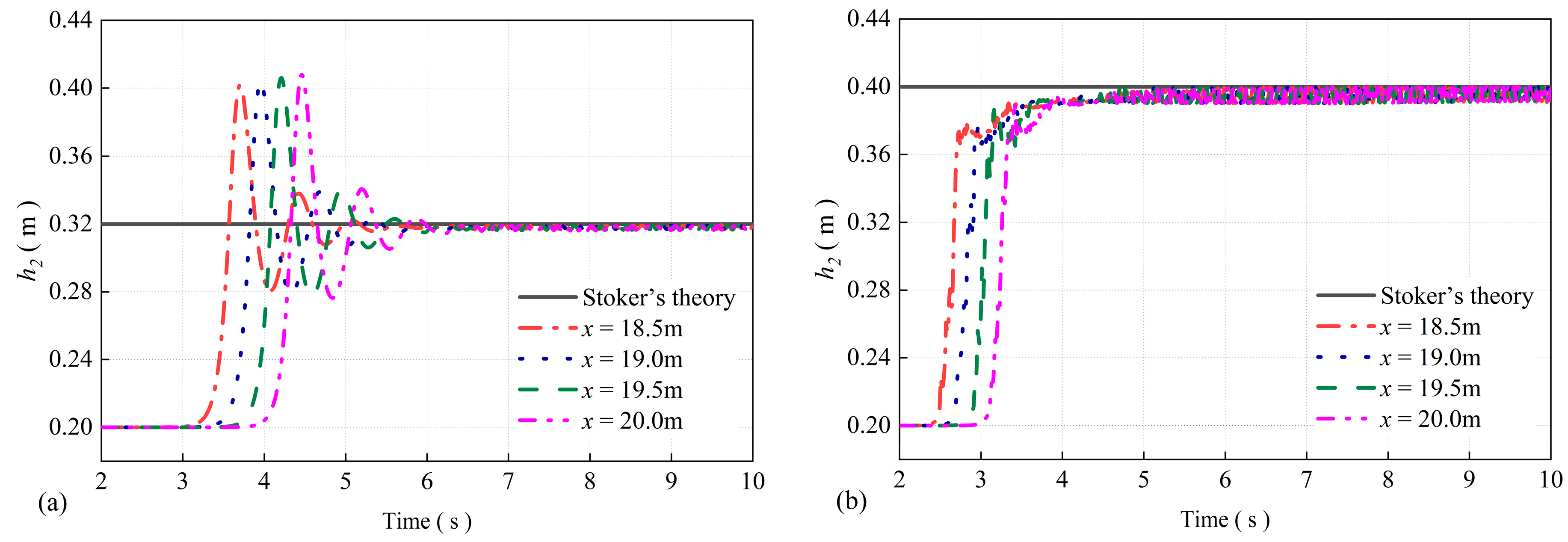
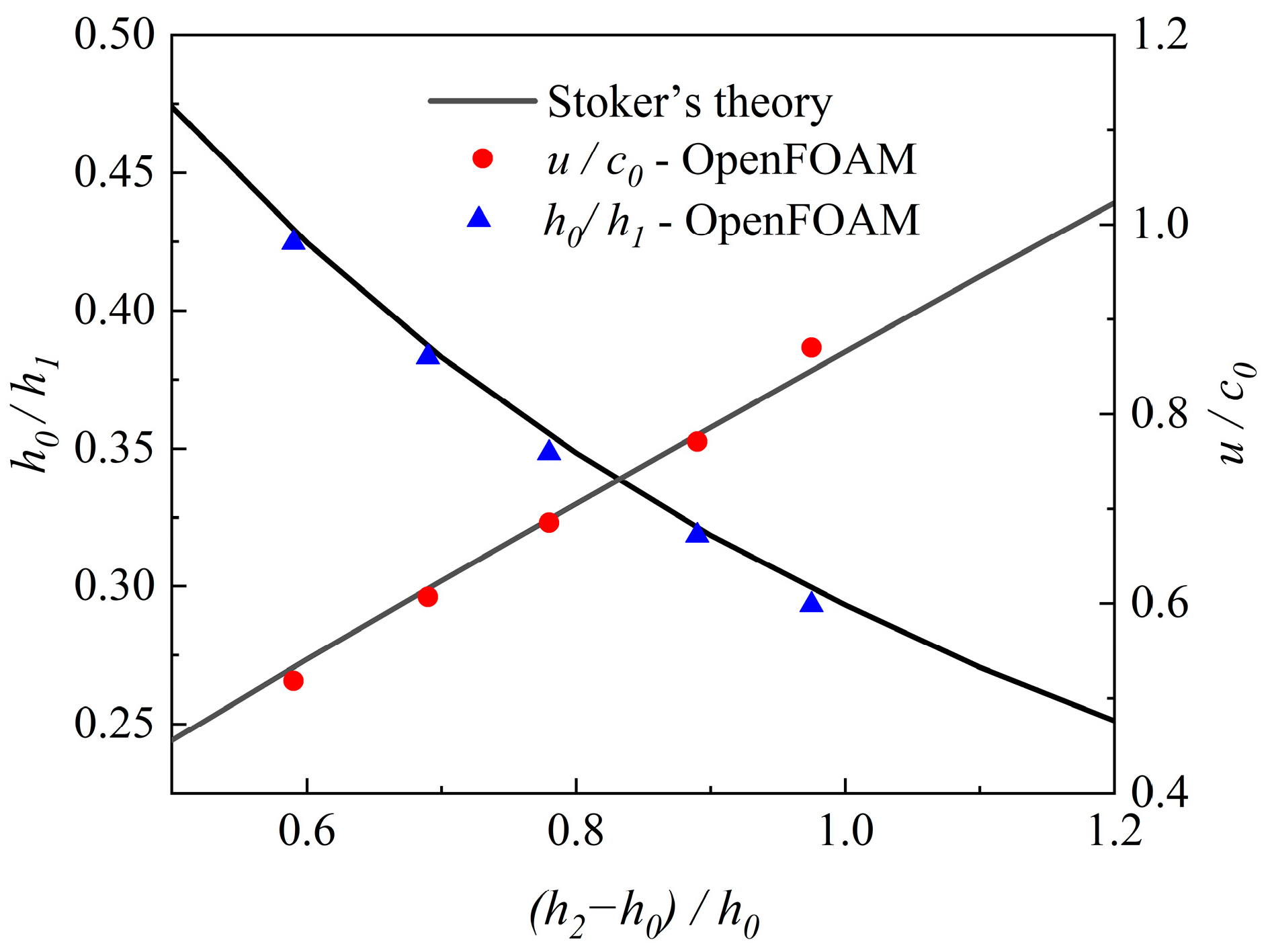
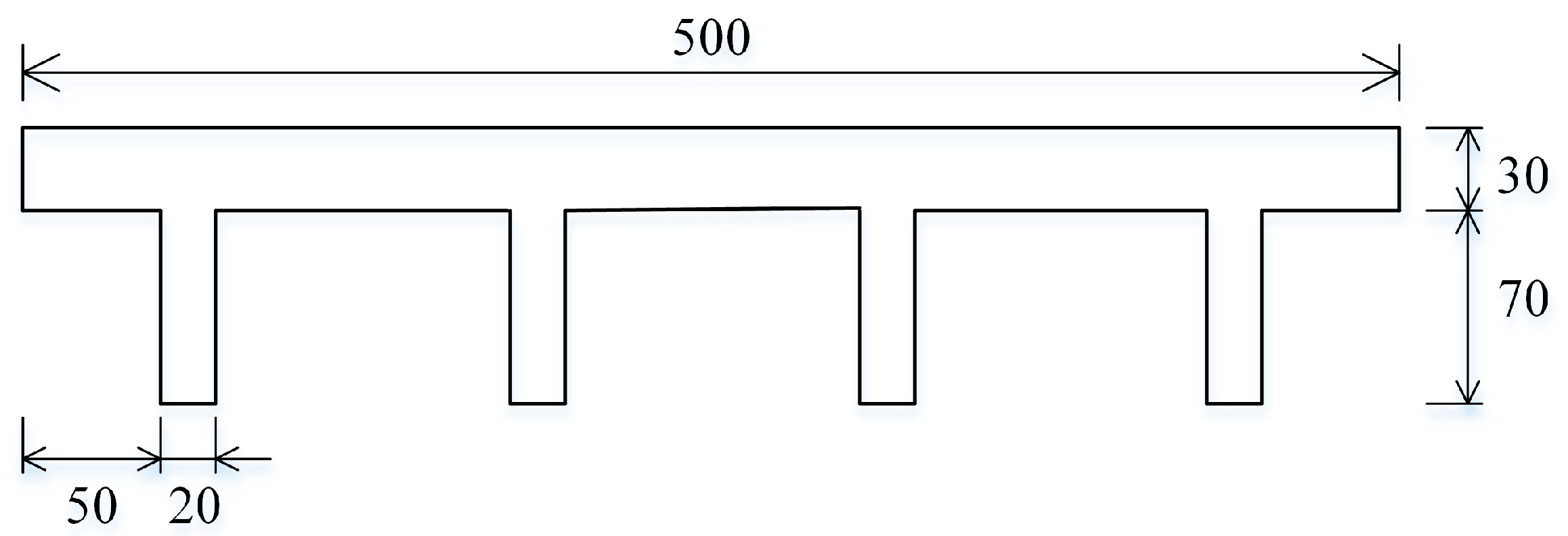



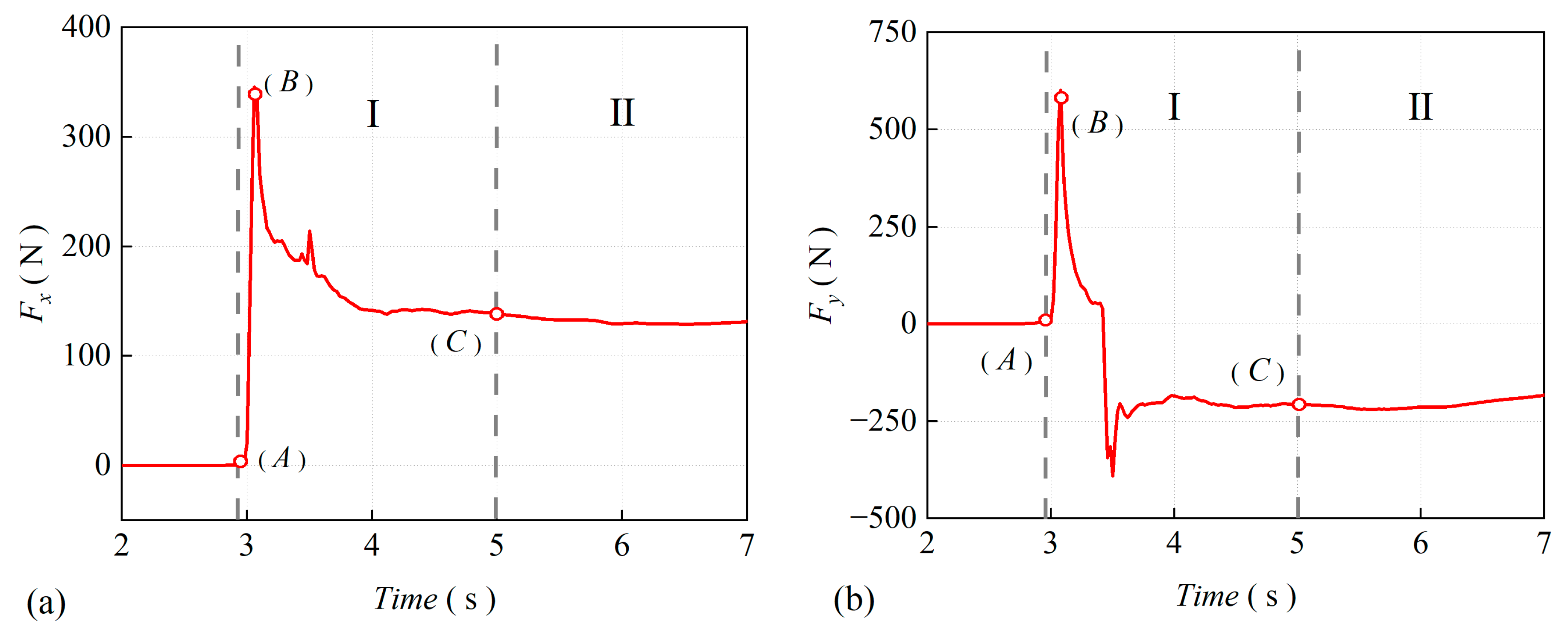




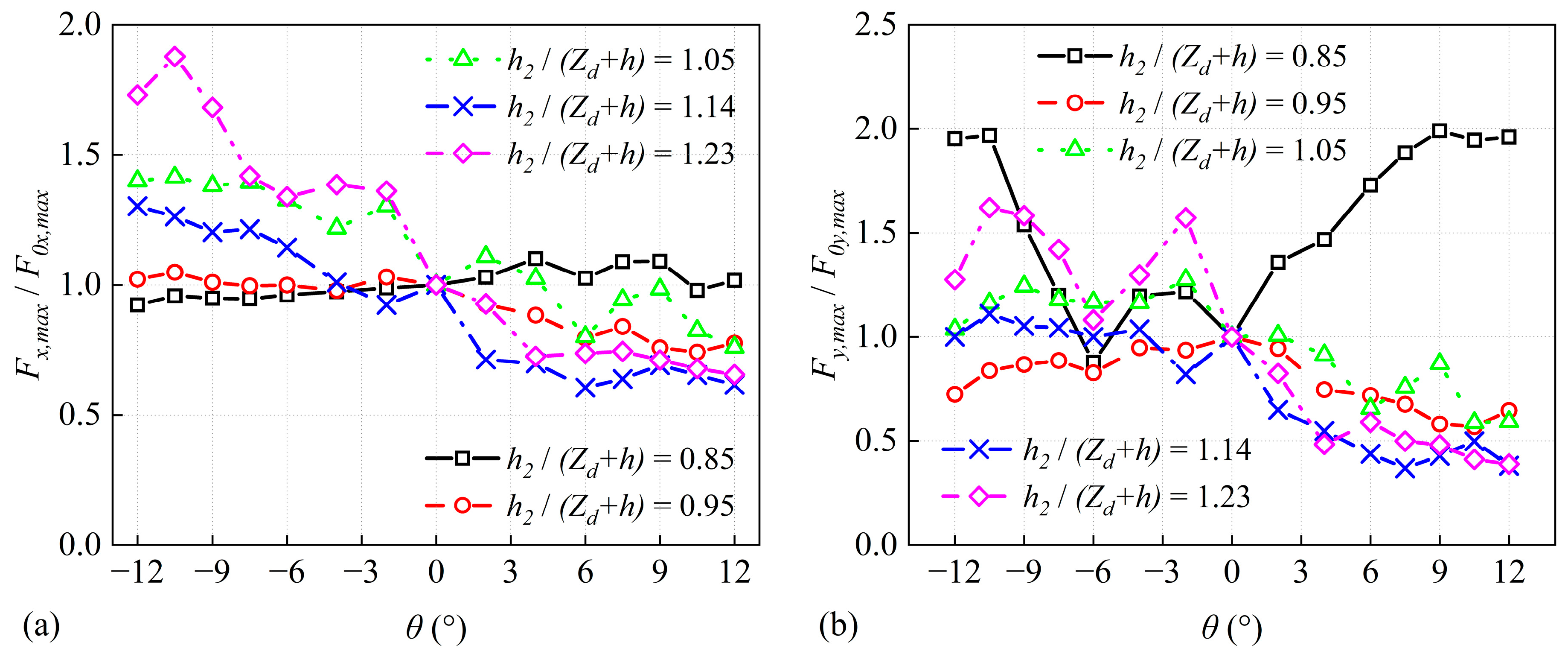
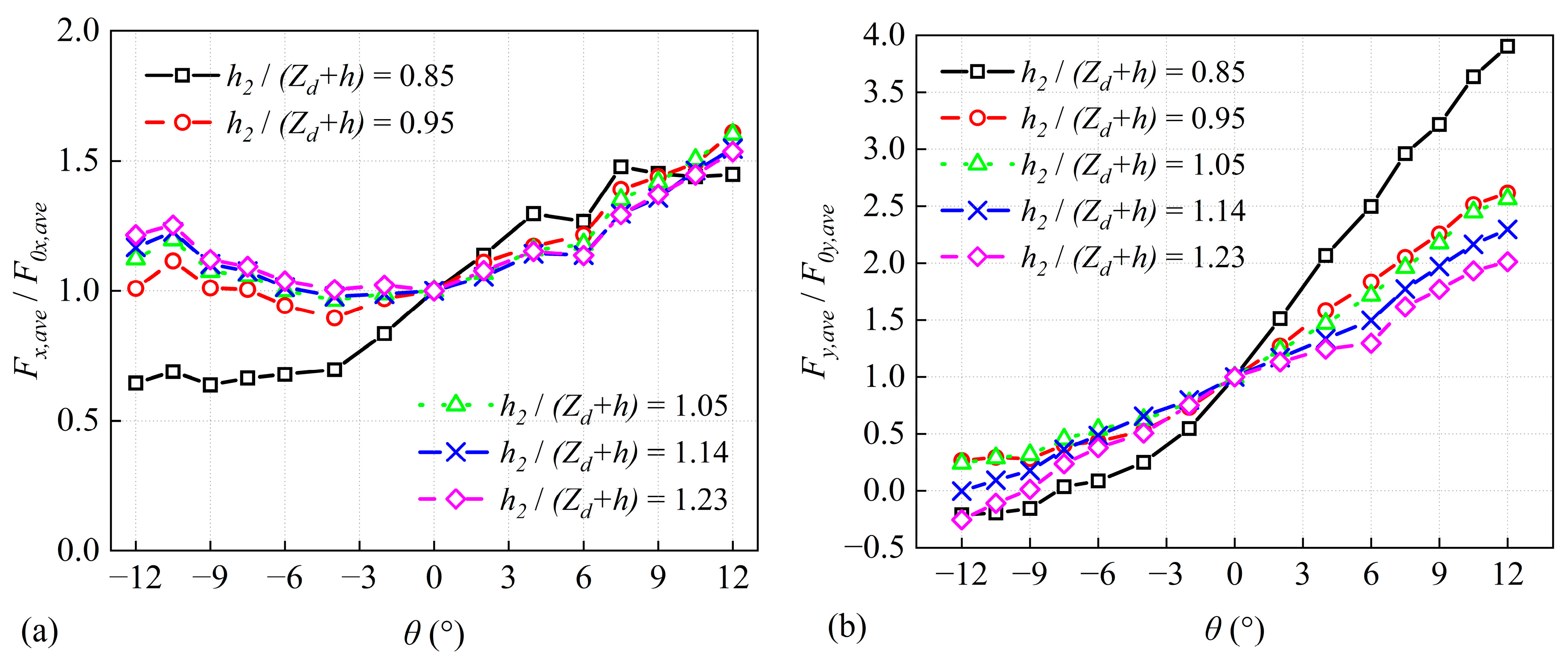
| Boundary | α1 | ε | k | prgh | U |
|---|---|---|---|---|---|
| Bottom | zeroGradient | epsilonWallFunction | kqRWallFunction | fixedFluxPressure | fixedValue |
| Left wall | zeroGradient | epsilonWallFunction | kqRWallFunction | fixedFluxPressure | fixedValue |
| Right wall | zeroGradient | epsilonWallFunction | kqRWallFunction | fixedFluxPressure | fixedValue |
| Atmosphere | inletOutlet | zeroGradient | zeroGradient | totalPressure | pressureInletOutletVelocity |
| Bridge model | zeroGradient | epsilonWallFunction | kqRWallFunction | fixedFluxPressure | fixedValue |
| Front wall | zeroGradient | epsilonWallFunction | kqRWallFunction | fixedFluxPressure | fixedValue |
| Back wall | zeroGradient | epsilonWallFunction | kqRWallFunction | fixedFluxPressure | fixedValue |
| Cell Length (m) | Total Mesh Number | Calculation Time (h) |
|---|---|---|
| 0.05 | 526,041 | 1.32 |
| 0.025 | 691,829 | 2.05 |
| 0.0125 | 2,074,903 | 9.47 |
| 0.00625 | 13,431,024 | 235 |
Disclaimer/Publisher’s Note: The statements, opinions and data contained in all publications are solely those of the individual author(s) and contributor(s) and not of MDPI and/or the editor(s). MDPI and/or the editor(s) disclaim responsibility for any injury to people or property resulting from any ideas, methods, instructions or products referred to in the content. |
© 2023 by the authors. Licensee MDPI, Basel, Switzerland. This article is an open access article distributed under the terms and conditions of the Creative Commons Attribution (CC BY) license (https://creativecommons.org/licenses/by/4.0/).
Share and Cite
Song, Y.; Jia, J.; Liu, H.; Chen, F.; Fang, Q. Numerical Study on Tsunami Force on Coastal Bridge Decks with Superelevation. J. Mar. Sci. Eng. 2023, 11, 824. https://doi.org/10.3390/jmse11040824
Song Y, Jia J, Liu H, Chen F, Fang Q. Numerical Study on Tsunami Force on Coastal Bridge Decks with Superelevation. Journal of Marine Science and Engineering. 2023; 11(4):824. https://doi.org/10.3390/jmse11040824
Chicago/Turabian StyleSong, Yang, Jingtao Jia, Haibin Liu, Fang Chen, and Qinghe Fang. 2023. "Numerical Study on Tsunami Force on Coastal Bridge Decks with Superelevation" Journal of Marine Science and Engineering 11, no. 4: 824. https://doi.org/10.3390/jmse11040824
APA StyleSong, Y., Jia, J., Liu, H., Chen, F., & Fang, Q. (2023). Numerical Study on Tsunami Force on Coastal Bridge Decks with Superelevation. Journal of Marine Science and Engineering, 11(4), 824. https://doi.org/10.3390/jmse11040824






